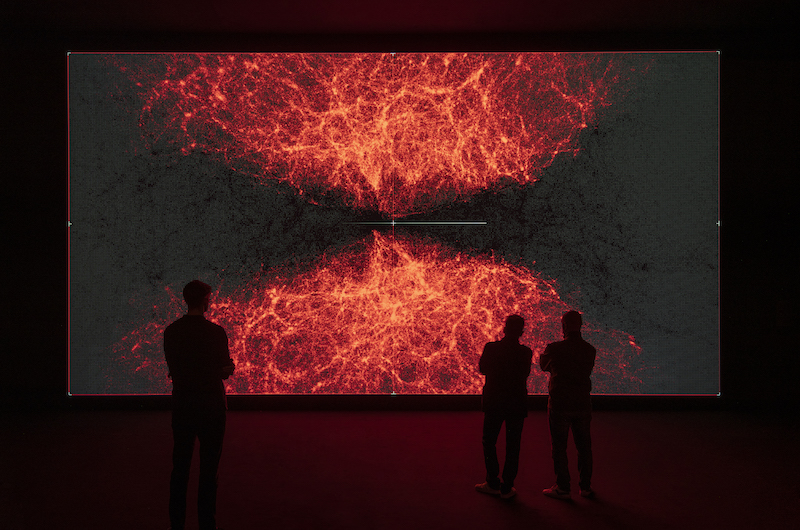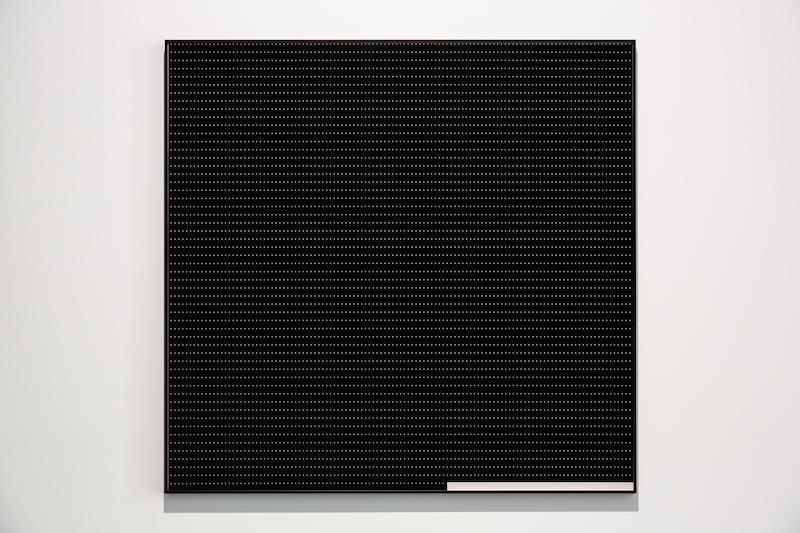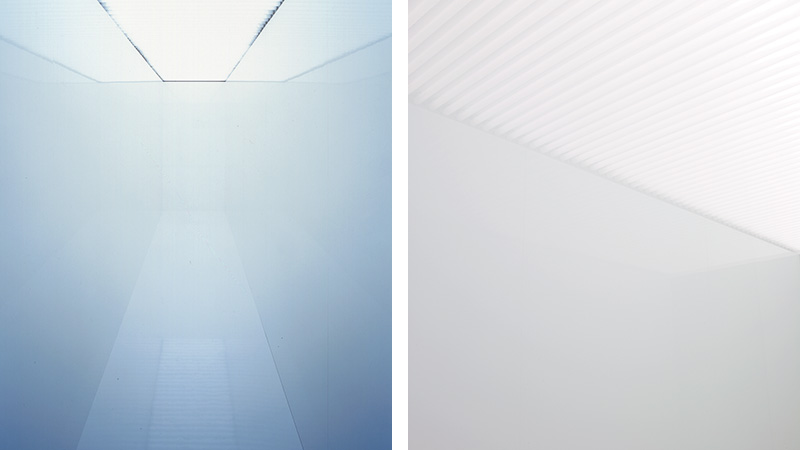Ryoji Ikeda - the artist who conquered mathematics

Ryoji Ikeda – composer and minimalist working with the exact sciences. He draws his inspiration from science, especially mathematics. In an article for TheStatusSymbol.com curator, art critic, journalist, public founder art.times Natalia Goryunova talks about a contemporary artist who combined light and sound into impressive art.
How much information does a person consume per day: sounds, signs, images. We open our eyes and begin to read space and objects with our senses. Without respite, we receive information about what is happening in our field of vision and hearing.
Ikeda's works are a demonstration of the information field that surrounds us every day. In his installations, the artist reveals the true power and power of the billions of bits processed by humans.
Ikeda's media art is an image moving at 100 frames per second. This pace is not accessible to our perception, and the attempt to catch elusive amounts of information creates a hypnotic effect. Ikeda works with the perception of visual and auditory information, showing scientific data from various fields: programming, mathematics, physics and chemistry. On the projection we see: stripes, initial data, barcodes, transcendental number, molecular structure of substances and DNA sequence, navigation scan of the Universe and Ikeda's space objects.
His music is a symphony of white noise and sine waves. Visitors are immersed in sounds that are not like music as it is usually presented.
Entering the installations, the visitor is immersed in a stream of flickering images and low/high frequency sounds. All of Ikeda’s videos work on the principle of increasing dynamics, from calm ones they develop into a whole storm, changing pictures, the tempo of the melody increases.
Ryoji Ikeda is a composer and minimalist working with the exact sciences. He finds his inspiration in science, and especially in mathematics.
“In my opinion, mathematics is the most beautiful thing in the world! Numbers, quantities and shapes are perfect regardless of how we perceive them, what meanings we put into them,” - Ryoji Ikeda
In both video art and objects, Ikeda often works with numbers. It uses millions of digits from the transcendental number, which are generated using a special program. Each visitor receives a personalized experience. The number is not repeated twice. A transcendental number is a number that cannot be calculated by algebra or expressed algebraically.
Ikeda is Japan's leading electronic composer, whose musical works are based on working with the characteristics of sound itself. It uses sound signals that are outside the scope of musical literacy and are not perceived as music by humans. However, this did not stop him from gathering a large audience of fans and becoming a recognized world musician and media artist.
Ikeda's installations and video art are shown in museums and galleries: Japan, France, USA, Spain, Russia, Holland, Australia... At the Venice Biennale 2019, Ikeda presented two of his works: “Code-Verse” and “Spectra”. The artist is represented by the gallery Almine Rech Gallery (Brussels, Paris, London, New York).
Music by Ryoji Ikeda
His music hardly fits into the usual forms of this concept. This is a thriller of generator hum or low/high frequency sine waves connected to a beat.
The artist has been creating media art since 2000; he made his first work “Cyclo” together with Nikolai Karsten, who visualized his unusual music. At the same time, he used geometric figures that changed when beaten: the figure became three-dimensional, disintegrated into edges and changed its position in space.
One of Ikeda's works refers us to another famous musical reformer, John Cage. Ikeda's work 4,33 consists of 16mm blank videotape.

World
In addition to working with music and video, Ikeda uses light in his works. In the project “Spectra” (2000), a new version of which was shown at the Venice Biennale 2019, Ikeda invited visitors to walk through an elongated corridor filled with light. The maximum power of light completely fills the space and does not allow viewers to look and open their eyes completely. A person entering inside sees practically nothing, as if he were in pitch darkness. Each visitor receives an individual experience and reaction, because in the absence of pure vision, all other senses increase their work. The installation is complemented by sound fields; when passing through them, at different speeds, the visitor receives different vibrations, and therefore sounds.

Space
Media art is located in fairly large spaces: 38-meter walls of museums, the work “The Radar” was projected onto the French royal palace of Versailles. This amazing sight was complemented by the reflection in the water. It is no coincidence that Ikeda chooses such large spaces. This is another hint at the impossibility of assimilating all the information in full. The viewer, immersed in sound, light and space, receives a “total sensory experience.”
Author: Natalia Goryunova
Ryoji Ikeda – composer and minimalist working with the exact sciences. He draws his inspiration from science, especially mathematics. In an article for TheStatusSymbol.com curator, art critic, journalist, public founder art.times Natalia Goryunova talks about a contemporary artist who combined light and sound into impressive art.
How much information does a person consume per day: sounds, signs, images. We open our eyes and begin to read space and objects with our senses. Without respite, we receive information about what is happening in our field of vision and hearing.
Ikeda's works are a demonstration of the information field that surrounds us every day. In his installations, the artist reveals the true power and power of the billions of bits processed by humans.
Ikeda's media art is an image moving at 100 frames per second. This pace is not accessible to our perception, and the attempt to catch elusive amounts of information creates a hypnotic effect. Ikeda works with the perception of visual and auditory information, showing scientific data from various fields: programming, mathematics, physics and chemistry. On the projection we see: stripes, initial data, barcodes, transcendental number, molecular structure of substances and DNA sequence, navigation scan of the Universe and Ikeda's space objects.
His music is a symphony of white noise and sine waves. Visitors are immersed in sounds that are not like music as it is usually presented.
Entering the installations, the visitor is immersed in a stream of flickering images and low/high frequency sounds. All of Ikeda’s videos work on the principle of increasing dynamics, from calm ones they develop into a whole storm, changing pictures, the tempo of the melody increases.
Ryoji Ikeda is a composer and minimalist working with the exact sciences. He finds his inspiration in science, and especially in mathematics.
“In my opinion, mathematics is the most beautiful thing in the world! Numbers, quantities and shapes are perfect regardless of how we perceive them, what meanings we put into them,” - Ryoji Ikeda
In both video art and objects, Ikeda often works with numbers. It uses millions of digits from the transcendental number, which are generated using a special program. Each visitor receives a personalized experience. The number is not repeated twice. A transcendental number is a number that cannot be calculated by algebra or expressed algebraically.
Ikeda is Japan's leading electronic composer, whose musical works are based on working with the characteristics of sound itself. It uses sound signals that are outside the scope of musical literacy and are not perceived as music by humans. However, this did not stop him from gathering a large audience of fans and becoming a recognized world musician and media artist.
Ikeda's installations and video art are shown in museums and galleries: Japan, France, USA, Spain, Russia, Holland, Australia... At the Venice Biennale 2019, Ikeda presented two of his works: “Code-Verse” and “Spectra”. The artist is represented by the gallery Almine Rech Gallery (Brussels, Paris, London, New York).
Music by Ryoji Ikeda
His music hardly fits into the usual forms of this concept. This is a thriller of generator hum or low/high frequency sine waves connected to a beat.
The artist has been creating media art since 2000; he made his first work “Cyclo” together with Nikolai Karsten, who visualized his unusual music. At the same time, he used geometric figures that changed when beaten: the figure became three-dimensional, disintegrated into edges and changed its position in space.
One of Ikeda's works refers us to another famous musical reformer, John Cage. Ikeda's work 4,33 consists of 16mm blank videotape.

World
In addition to working with music and video, Ikeda uses light in his works. In the project “Spectra” (2000), a new version of which was shown at the Venice Biennale 2019, Ikeda invited visitors to walk through an elongated corridor filled with light. The maximum power of light completely fills the space and does not allow viewers to look and open their eyes completely. A person entering inside sees practically nothing, as if he were in pitch darkness. Each visitor receives an individual experience and reaction, because in the absence of pure vision, all other senses increase their work. The installation is complemented by sound fields; when passing through them, at different speeds, the visitor receives different vibrations, and therefore sounds.

Space at Reji Ikeda
Media art is located in fairly large spaces: 38-meter walls of museums, the work “The Radar” was projected onto the French royal palace of Versailles. This amazing sight was complemented by the reflection in the water. It is no coincidence that Ikeda chooses such large spaces. This is another hint at the impossibility of assimilating all the information in full. The viewer, immersed in sound, light and space, receives a “total sensory experience.”
Author: Natalia Goryunova


